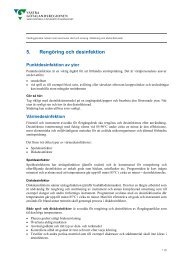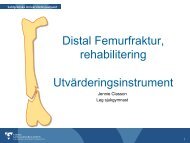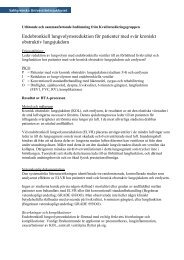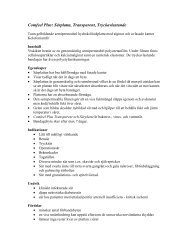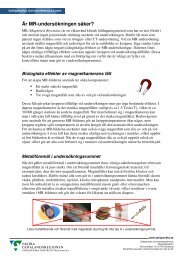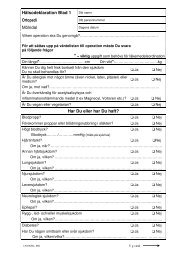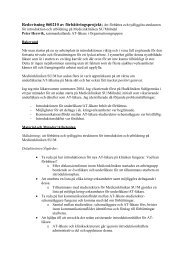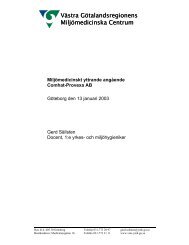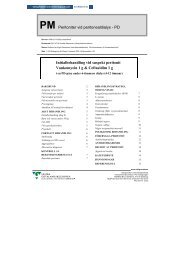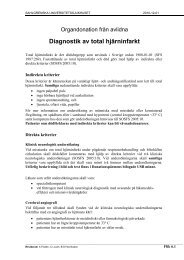HTA - Sahlgrenska Universitetssjukhuset
HTA - Sahlgrenska Universitetssjukhuset
HTA - Sahlgrenska Universitetssjukhuset
You also want an ePaper? Increase the reach of your titles
YUMPU automatically turns print PDFs into web optimized ePapers that Google loves.
Physiotherapy<br />
Physiotherapy is one of the first line interventions in management of painful<br />
musculoskeletal conditions of the shoulder (Green et al., 2003; Denard et al., 2011).<br />
The specific treatment modalities include therapeutic exercise, manual mobilization,<br />
acupuncture and TENS (Transcutaneus Electric Neuro Stimulation). Therapeutic<br />
exercises are well documented, and can restore function and reduce pain (van der<br />
Heijden et al., 1997; Marinko et al., 2011; Farr et al., 2010). Well-structured exercise<br />
programs have been shown to be more efficient than self-management in<br />
osteoarthritis of the knee joint (Farr), and it is most probably the case also for<br />
shoulder osteoarthritis (Marinko).<br />
Surgery<br />
Patients who do not achieve an acceptable pain relief and/or function by nonsurgical<br />
interventions can be treated with arthroscopic debridement or with prosthetic<br />
arthroplasty. There are two major types of prosthetic surgery; total shoulder<br />
arthroplasty and hemiarthroplasty. In the former both the humeral head and the<br />
glenoid cavity is replaced by prosthesis, whereas in HA the humeral head is replaced<br />
by an implanted prosthesis.<br />
2d Number of patients per year who undergo current treatment regimen?<br />
During 2010 a total of 37 shoulder arthroplasties due to primary osteoarthritis were<br />
performed in Region Västra Götaland. The number of such patients had increased to<br />
56 during 2011. The corresponding total numbers of shoulder arthroplasties due to<br />
any reason and including trauma diagnoses increased from 122 to 171. Of these 14<br />
and 22 were revision procedures.<br />
It is estimated that the need for shoulder arthroplasty in Region Västra Götaland is<br />
about 200 patients per year. This would imply an increase the next coming years of<br />
about 10 % per year, i.e. about 17 additional patients each year.<br />
2e The normal pathway of a patient through the health care system<br />
Patients with glenohumoral osteoarthritis are normally first treated by general<br />
practitioners in the out-patient setting. Most patients are evaluated by physical<br />
examination and a conventional radiographic examination of the shoulder.<br />
Severe cases with therapy-resistant symptoms will be referred to an orthopedic<br />
surgeon. The normal wait time from referral to a first visit to the orthopedic surgeon<br />
is about three months.<br />
The great majority of these severe cases will then be subject to about six months of<br />
well-structured exercises and manual manipulation. If there has not been a sufficient<br />
reduction of pain, restoration of range of motion and function, after this period the<br />
patient is reassessed for consideration of surgical treatment.<br />
2f Actual wait time in days for medical assessment /treatment<br />
Once the decision to perform arthroplasty has been made the wait time for surgery is<br />
less than three months.<br />
8(17)



